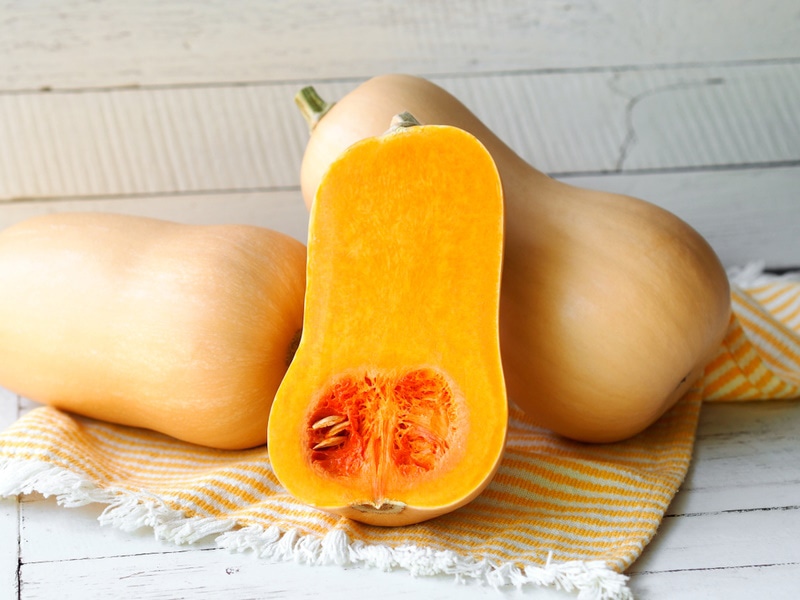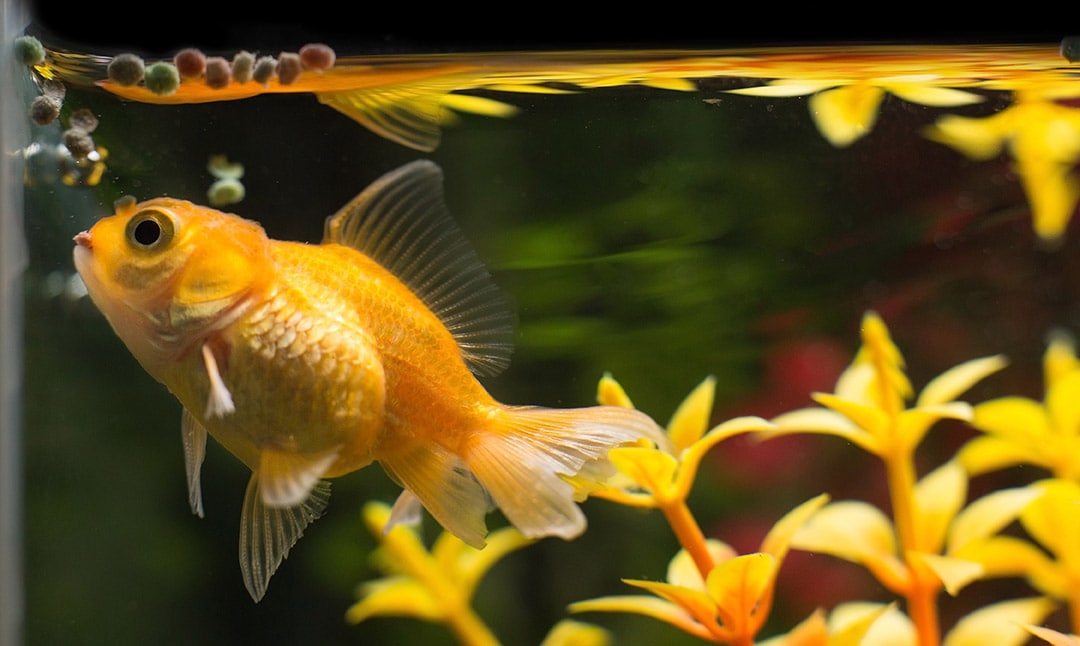

Goldfish can live for decades with proper care. Of course, this requires proper tank cleaning and maintenance, monitoring for diseases and health changes, providing clean water, and ensuring your goldfish has an overall enriching environment. One of the most important aspects that is frequently overlooked, though, is diet.
Goldfish require a more varied diet than you might realize, and they can eat tons of different foods. Knowing how to balance your goldfish’s diet between necessities, basics, and treats will help you ensure your goldfish will be with you for years to come. Let’s dive right into the best diet to keep your goldfish healthy.

Can’t I Just Feed My Goldfish Fish Food Flakes?
The simplest answer to this is “yes”, and you’ll almost certainly encounter someone who kept their goldfish alive on nothing but the same brand of flakes for 20 years. There are a few reasons why that isn’t ideal and won’t work for all goldfish. In reference to fish food flakes specifically, these foods contain a lower nutrient density and more fillers than most other types of fish foods. Pellets and bars tend to have a higher nutrient density than flakes, and they are less likely to disintegrate quickly and foul the water.

Basic Nutrition
Commercial fish foods are made with nutrition basics in mind. This means they are formulated to meet the basic needs of maintaining life, and little else. To put this into perspective, imagine we’re talking about feeding a dog. Some people feed their dog the same kibble its entire life, but the majority of dog owners feed based on life stage, because puppies, adults, seniors, underweight, overweight, and active dogs all have different nutritional needs.
In addition to kibble, you may also give your dog a vitamin or joint supplement. You may feed table scraps from time to time. You likely give treats, whether it’s multiple times per day or on occasion. Your dog might like to sneak veggies from your garden, or snack on fresh spring grass. All of these foods play a different role in your dog’s health. The kibble on its own technically meets all baseline nutritional needs, but all of these foods and treats together form a more complete nutrient profile. The same is true for your goldfish. A varied, balanced diet supports a more complete picture of health.
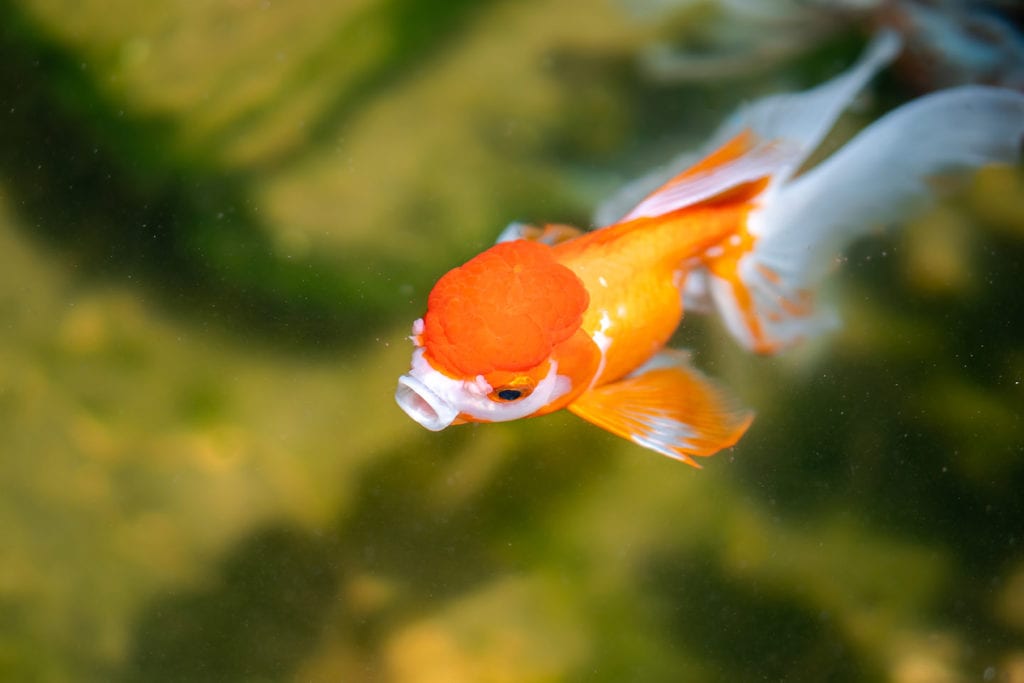
Foraging is Important
Another problem with feeding just fish food flakes, or even pellets for that matter, is that it doesn’t meet your goldfish’s natural urge to forage and snack throughout the day. In nature, goldfish eat all day long. They eat insects, small crustaceans, and plants. Feeding your goldfish a sprinkle of fish food once or twice a day meets the basic nutritional needs, but it doesn’t allow for the enrichment and nutrition of foraging. This can lead to boredom and often results in goldfish uprooting or eating plants you want to keep.

The Basics of a Goldfish Diet
The base of your goldfish’s diet should be commercial fish food. This will ensure that all basic nutritional needs are met. This can consist of pellets, bars, crisps, flakes, wafers, or gel food. Ideally, a rotation of different foods will help ensure variety and nutritional soundness. Aim for foods that have a protein or plant source as the first few ingredients. Avoid foods with lots of fillers, like corn. Most commercial foods will have some form of filler, so read the ingredients on the label to determine how low on the list the fillers are versus more nutrient-dense foods, like spirulina and shrimp.
- Pellets: These are available in floating, sinking, and slow-sinking Some people feel that floating foods cause swim bladder problems, especially in fancies. Sinking and slow-sinking varieties may be best for most goldfish, but you may have to use trial and error to find out what works best for your goldfish.
- Flakes: Flake foods usually float, and leftovers are more difficult to clean up than other types of foods, like pellets. And while flakes are usually less nutrient-dense than other foods, there are healthy flake varieties on the market.
- Crisps: Crisps are similar to flakes in nutrition but are easier to clean up and might be less likely to foul your water due to their more physically dense nature.
- Bars/Sticks: These are usually similar in nutrition to pellets. Bar/stick foods are usually a cost-effective option for feeding ponds and large tanks with multiple goldfish.
- Wafers: Wafer foods are rarely formulated specifically for goldfish. They are usually formulated for herbivores and bottom feeders. Goldfish will happily eat algae wafers and other wafer varieties, but they almost always need a more nutritionally sound diet that is intended specifically for goldfish.
- Gel Food: These foods are a newer variety on the commercial market, and they require you to mix up a powder base with hot water, creating a gel texture. Gel foods tend to be very nutrient dense and have a much shorter shelf life than other commercial foods.
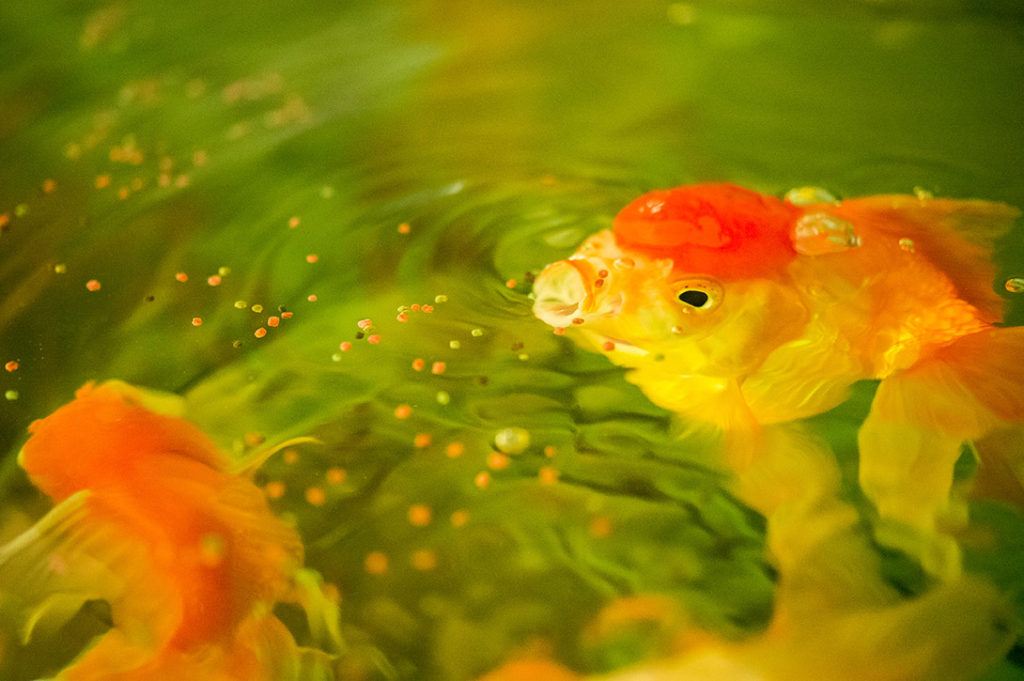
The Necessities
Goldfish should always be provided access to leafy green plants. This will keep them busy and satiated throughout the day. Goldfish aren’t pick with aquatic plants and will eat many of them, although duckweed and water lettuce seem to be favorites. Here are some “people” foods that you can give your goldfish access to all the time:
- Herbs: Basil, cilantro, and parsley are usually well-received. Your goldfish may also enjoy thyme, mint, and oregano.
- Leafy Greens: Arugula, spinach, romaine lettuce, tender spring greens, chard, kale, dandelion greens, mustard greens, turnip greens, and cabbage are all goldfish friendly.
Fruit and Veggie Treats
Fruits and veggies not listed above should be fed as treats. They can be fed as a replacement for herbs or leafy greens on an occasional basis but should not make up a main portion of your goldfish’s diet.
- Fruits: Apples, banana, melon (watermelon, cantaloupe, honeydew), skinned grapes, pears, oranges, grapefruit, berries (strawberries, raspberries, blueberries), avocado,
- Veggies: Winter squash (butternut, acorn, pumpkin), summer squash (zucchini, yellow), broccoli, cauliflower, brussels sprouts, carrots, cucumber, skinned peas, skinned lima beans, sweet potato, green beans, asparagus, bell pepper
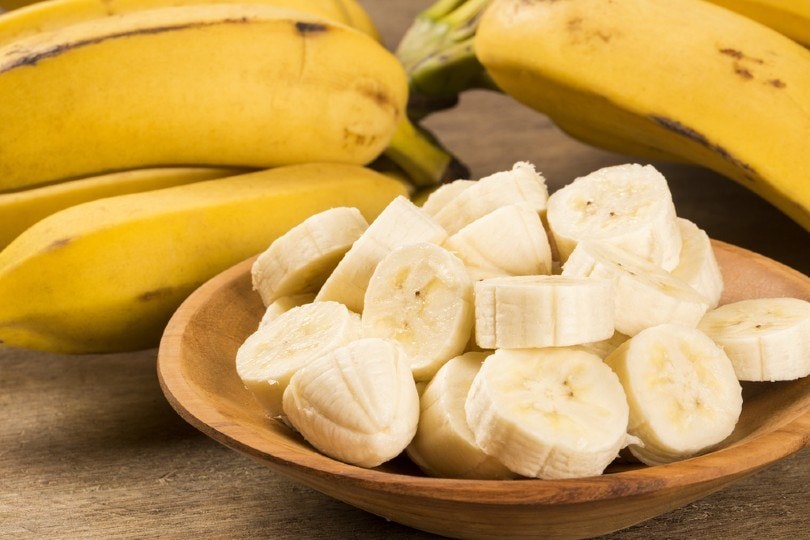
Protein Treats
These treats can mostly be found at pet stores, aquatic stores, and online vendors, although some of these are as close as your backyard. Proteins can cause constipation in large quantities and should be fed sparingly as treats once or twice weekly. Proteins can be freeze-dried, thawed frozen, fresh, or live.
- Earthworms/Nightcrawlers: These can be sourced from your own yard if you are certain they have not come in contact with pesticides or other potential toxins.
- Red worms/Red Wigglers
- Black Soldierfly Larvae
- Daphnia
- Brine Shrimp
- Krill
- Bloodworms
- Mysis shrimp
- Cooked, unseasoned shrimp
- Mosquito larvae
Proceed with Caution
- Potato
- Corn
- Eggplant
- Tomato
- Bread
- Meat (cooked chicken, turkey, beef)
Foods Not to Feed
- Rosemary
- Canned fish/shellfish
- Dairy
- Lemons
- Limes
- Fried foods
- Salty foods
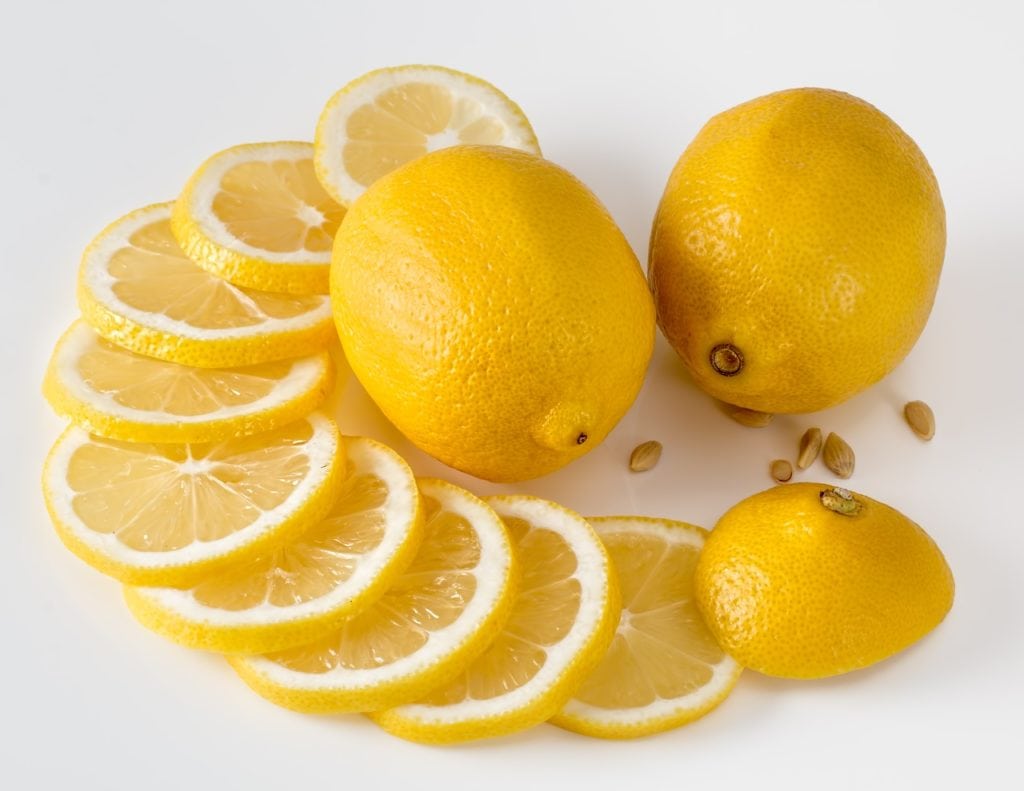
How Do I Feed Fresh Foods to My Goldfish?
When it comes to feeding fresh fruits and veggies to your goldfish, there are a few things to consider. It’s best to steam, blanch, or boil anything before feeding to your goldies. This ensures they can tear, chew, and digest the food. Foods with thin skins, like grapes and peas, should have the skin removed. Foods with thicker skins, like cucumbers and zucchini, should be peeled and seeds should be removed.
Leafy greens, bananas, avocado, and other soft foods can be offered in whole pieces since your goldfish will be able to manage the food. Harder foods or foods that may be difficult to “catch”, like carrots and peas, should be chopped into bitesize or manageable pieces. Food clips and kabob skewers are great options for offering fresh foods to your goldfish.

In Conclusion
Offering novel foods to your goldfish can be fun, especially when you find something they particularly like. Keep in mind that goldfish coming from breeding environments have often been raised on commercial fish foods and have not been given access to fresh foods. It may take time for your goldfish to take to eating fresh foods, and this is totally normal. If you were raised on sugary breakfast cereal and hamburgers, then it would take you time to adjust to eating a salad. Be patient and have fun!
Featured Image Credit: oatpost, Shutterstock
Brooke Billingsley spent nine years as a veterinary assistant before becoming a human nurse in 2013. She resides in Arkansas with her boyfriend of five years. She loves all animals and currently shares a home with three dogs, two cats, five fish, and two snails. She has a soft spot for special needs animals and has a three-legged senior dog and an internet famous cat with acromegaly and cerebellar hypoplasia. Fish keeping has become a hobby of Brooke’s and she is continually learning how to give her aquarium pets the best life possible. Brooke enjoys plants and gardening and keeps a vegetable garden during the summer months. She stays active with yoga and obtained her 200-hour yoga teacher certification in 2020. She hosts a podcast focusing on folklore and myth and loves spending her free time researching and writing. Brooke believes that every day is an opportunity for learning and growth and she spends time daily working toward new skills and knowledge.


